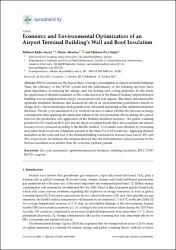Economic and Environmental Optimization of an Airport Terminal Building's Wall and Roof Insulation
Özet
HVAC systems use the largest share of energy consumption in airport terminal buildings. Thus, the efficiency of the HVAC system and the performance of the building envelope have great importance in reducing the energy used for heating and cooling purposes. In this study, the application of thermal insulation on the walls and roof of the Hasan Polatkan Airport terminal building was investigated from energy, environment and cost aspects. This study determined the optimum insulation thickness and assessed its effects on environmental performance based on energy flows. Environmental payback periods were calculated depending on the optimum insulation thickness. The life cycle assessment (LCA) method was used to assess whether the decrease in energy consumption after applying the insulation balanced the environmental effects during the period between the production and application of the thermal insulation material. The global warming potential (GWP) based on IPCC100, and the effects on human health (HH), the ecosystem and natural resources were evaluated according to the ReCiPe method. LCA results were obtained by processing data taken from ecoinvent 3 database present in the Sima Pro 8.3.0.0 software. Applying thermal insulation on the walls and roof of the terminal building was found to decrease heat loss by 48% and 56%, respectively. In addition, the analyses showed that the environmental payback periods for the thermal insulation were shorter than the economic payback periods.


















